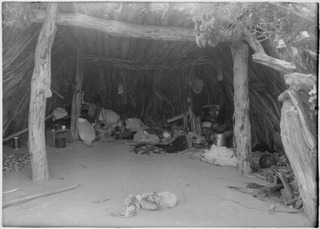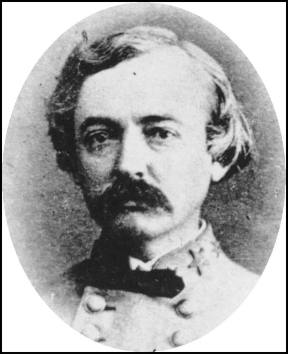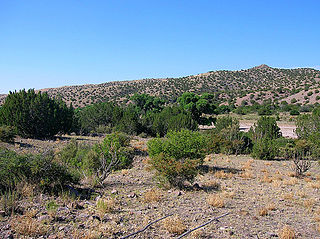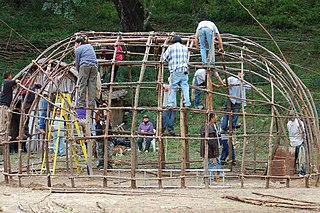
The Battle of Westport, sometimes referred to as the "Gettysburg of the West", was fought on October 23, 1864, in modern Kansas City, Missouri, during the American Civil War. Union forces under Major General Samuel R. Curtis decisively defeated an outnumbered Confederate force under Major General Sterling Price. This engagement was the turning point of Price's Missouri Expedition, forcing his army to retreat. The battle ended the last major Confederate offensive west of the Mississippi River, and for the remainder of the war the United States Army maintained solid control over most of Missouri. This battle was one of the largest to be fought west of the Mississippi River, with over 30,000 men engaged.

The Apache Wars were a series of armed conflicts between the United States Army and various Apache tribal confederations fought in the southwest between 1849 and 1886, though minor hostilities continued until as late as 1924. After the Mexican–American War in 1846, the United States annexed conflicted territory from Mexico which was the home of both settlers and Apache tribes. Conflicts continued as white colonizers came into traditional Apache lands to raise livestock and crops and to mine minerals.

The Red River War was a military campaign launched by the United States Army in 1874 to displace the Comanche, Kiowa, Southern Cheyenne, and Arapaho tribes from the Southern Plains, and forcibly relocate the tribes to reservations in Indian Territory. The war had several army columns crisscross the Texas Panhandle in an effort to locate, harass, and capture nomadic Native American bands. Most of the engagements were small skirmishes with few casualties on either side. The war wound down over the last few months of 1874, as fewer and fewer Indian bands had the strength and supplies to remain in the field. Though the last significantly sized group did not surrender until mid-1875, the war marked the end of free-roaming Indian populations on the southern Great Plains.

The Colorado War was an Indian War fought in 1864 and 1865 between the Southern Cheyenne, Arapaho, and allied Brulé and Oglala Sioux peoples versus the U.S. Army, Colorado militia, and white settlers in Colorado Territory and adjacent regions. The Kiowa and the Comanche played a minor role in actions that occurred in the southern part of the Territory along the Arkansas River. The Cheyenne, Arapaho, and Sioux played the major role in actions that occurred north of the Arkansas River and along the South Platte River, the Great Platte River Road, and the eastern portion of the Overland Trail. The United States government and Colorado Territory authorities participated through the 1st Colorado Cavalry Regiment, often called the Colorado volunteers. The war was centered on the Colorado Eastern Plains, extending eastward into Kansas and Nebraska.

The Battle of Valverde, also known as the Battle of Valverde Ford, was fought from February 20 to 21, 1862, near the town of Val Verde at a ford of the Rio Grande in Union-held New Mexico Territory, in what is today the state of New Mexico. It is considered a major Confederate success in the New Mexico Campaign of the American Civil War, despite the invading force abandoning the field and, eventually, retreating from the territory entirely. The belligerents were Confederate cavalry from Texas and several companies of Arizona militia versus U.S. Army regulars and Union volunteers from northern New Mexico Territory and the Colorado Territory.

The Kickapoo Tribe of Oklahoma is one of three federally recognized Kickapoo tribes in the United States. There are also Kickapoo tribes in Kansas, Texas, and Mexico. The Kickapoo are a Woodland tribe, who speak an Algonquian language. They are affiliated with the Kickapoo Traditional Tribe of Texas, the Kickapoo Tribe in Kansas, and the Mexican Kickapoo.

The Antelope Hills expedition was a campaign from January to May 1858 by the Texas Rangers and members of other allied Native American tribes against Comanche and Kiowa villages in the Comancheria. It began in western Texas and ended in a series of fights with the Comanche tribe on May 12, 1858, at a place called Antelope Hills by Little Robe Creek, a tributary of the Canadian River in what is now Oklahoma. The hills are also called the "South Canadians", as they surround the Canadian River. The fighting on May 12, 1858, is often called the Battle of Little Robe Creek.

William Henry Chase Whiting was a United States Army officer who resigned after 16 years of service in the Army Corps of Engineers to serve in the Confederate States Army during the American Civil War. He was wounded at the Second Battle of Fort Fisher by a musket ball to his leg, and died in prison camp on March 10, 1865, of dysentery.
The trans-Mississippi theater of the American Civil War was the scene of the major military operations west of the Mississippi River. The area is often thought of as excluding the states and territories bordering the Pacific Ocean, which formed the Pacific coast theater of the American Civil War (1861–1865).
The Texas–Indian wars were a series of conflicts between settlers in Texas and the Southern Plains Indians during the 19th-century. Conflict between the Plains Indians and the Spanish began before other European and Anglo-American settlers were encouraged—first by Spain and then by the newly Independent Mexican government—to colonize Texas in order to provide a protective-settlement buffer in Texas between the Plains Indians and the rest of Mexico. As a consequence, conflict between Anglo-American settlers and Plains Indians occurred during the Texas colonial period as part of Mexico. The conflicts continued after Texas secured its independence from Mexico in 1836 and did not end until 30 years after Texas became a state of the United States, when in 1875 the last free band of Plains Indians, the Comanches led by Quahadi warrior Quanah Parker, surrendered and moved to the Fort Sill reservation in Oklahoma.

During the American Civil War, most of what is now the U.S. state of Oklahoma was designated as the Indian Territory. It served as an unorganized region that had been set aside specifically for Native American tribes and was occupied mostly by tribes which had been removed from their ancestral lands in the Southeastern United States following the Indian Removal Act of 1830. As part of the Trans-Mississippi Theater, the Indian Territory was the scene of numerous skirmishes and seven officially recognized battles involving both Native American units allied with the Confederate States of America and Native Americans loyal to the United States government, as well as other Union and Confederate troops.

The Battle of Canada Alamosa as it was known to the Union Army, or Alamosa as it was known to the Confederates, was a skirmish of the American Civil War on the late evening of September 24 and the morning of September 25, 1861. It was one of several small battles that occurred in Confederate Arizona near the border with Union held New Mexico Territory, this one being the largest.

The Yuma War was the name given to a series of United States military operations conducted in southern California and what is today southwestern Arizona from 1850 to 1853. The Quechan were the primary opponent of the United States Army, though engagements were fought between the Americans and other native groups in the region.
The 36th Arkansas Infantry Regiment (1862–1865) was a Confederate Army regiment during the American Civil War. Originally known as McRea's Emergency Regiment, had been organized as the 28th Arkansas Infantry Regiment. After the Battle of Prairie Grove, the regiment was reorganized and designated the 36th Arkansas Infantry Regiment. The regiment is also referred to as the 2nd Trans-Mississippi Infantry Regiment, Glenn's Regiment, and Davie's Regiment.

The 3rd Arkansas Field Battery (1860–1865) was a Confederate Army artillery battery from Pulaski County, Arkansas, during the American Civil War. The battery is also known as the Totten Light Artillery, Pulaski Light Artillery, the Weaver Light Artillery, Woodruff's Battery, and Marshall's Battery. The battery originated as a pre-war Militia company, initially enrolled in state service. After the Battle of Wilson's Creek, the battery was released from state service and eventually reorganized for Confederate Service. The battery provided the initial training for the leaders of numerous other Arkansas artillery batteries during the Civil War. The battery spent its entire service in the Department of the Trans-Mississippi.

The Mexican Kickapoo are a binational Indigenous people, some of whom live both in Mexico and in the United States. In Mexico, they were granted land at Hacienda del Nacimiento near the town of Múzquiz in the state of Coahuila in 1850. A few small groups of Kickapoo also live in the states of Sonora and Durango. The Mexican Kickapoo often work as migrants in Texas and move throughout the Midwest and the Western United States, returning in winter to Mexico. They are affiliated with the federally recognized tribes of the Kickapoo Traditional Tribe of Texas, Kickapoo Tribe of Oklahoma, and Kickapoo Tribe in Kansas.
The Skirmish near Fort Thorn, New Mexico Territory, also known as the Fight at E Company Grove, was a skirmish of the American Civil War on the morning of September 26, 1861. It followed the Battle of Canada Alamosa one of several small battles that occurred near the border between Confederate Arizona and Union New Mexico Territory. This one being an attempt by detachments of three companies of the Union Regiment of Mounted Rifles to pursue the Confederate cavalry force of Captain Bethel Coopwood's San Elizario Spy Company, and detachments of Company B and E, Second Texas Mounted Rifles, that was retiring from their victory at Canada Alamosa toward their base at Camp Robledo, 12 miles north of Dona Ana, New Mexico.
The Second Battle of Cabin Creek was part of a plan conceived by Confederate Brigadier General Stand Watie, who had been promoted from colonel after the First Battle of Cabin Creek. The plan was to have a Confederate force attack central Kansas from Indian Territory, raiding Union Army facilities and encouraging Indian tribes in Western Kansas to join in an attack on the eastern part of the state. Watie presented the plan to his superior, General S. B. Maxey on February 5, 1864. Maxey approved the plan on the condition that the attack would start by October 1, to coincide with an attack on Missouri already planned by General Sterling Price.

The 32nd Texas Cavalry Regiment, sometimes incorrectly named Andrews's 15th Texas Cavalry Regiment, was a unit of volunteer cavalry mustered into the Confederate States Army in May 1862 and which fought during the American Civil War. The regiment was formed around companies from Richard Phillip Crump's 1st Texas Cavalry Battalion which fought in Indian Territory and at Pea Ridge. Many of the soldiers died of disease in the unhealthy camps near Corinth, Mississippi. The cavalrymen were dismounted in July 1862 and served as infantry for the rest of the war. The regiment fought at Richmond, Ky., Stones River, and Chickamauga in 1862–1863, in the Meridian and Atlanta campaigns and at Nashville in 1864, and at Spanish Fort and Fort Blakeley in 1865. The regiment's 58 surviving members surrendered to Federal forces on 9 May 1865.

The 24th and 25th Consolidated Texas Cavalry Regiment was a unit that originally consisted of two regiments of mounted volunteers that served in the Confederate States Army during the American Civil War. However, by the time the two regiments were consolidated, they fought as infantry. Both regiments organized as cavalry near Hempstead, Texas in April 1862 and were dismounted to fight as infantry in July 1862. The two regiments served in the same brigade and were captured at the Battle of Arkansas Post in January 1863. After being sent to Northern prison camps, the soldiers were exchanged in April 1863. Assigned to the Army of Tennessee, the two regiments were consolidated with two additional Texas cavalry regiments and in 1863 fought as infantry at Liberty Gap, Chickamauga, Missionary Ridge, and Ringgold Gap. In 1864, the other two Texas regiments were detached and the consolidated 24th and 25th fought as a separate infantry unit in the Atlanta campaign, at Franklin, and at Nashville. For the Carolinas campaign, the 24th and 25th fought at Bentonville before being reconsolidated with other Texas regiments and surrendering in April 1865.














